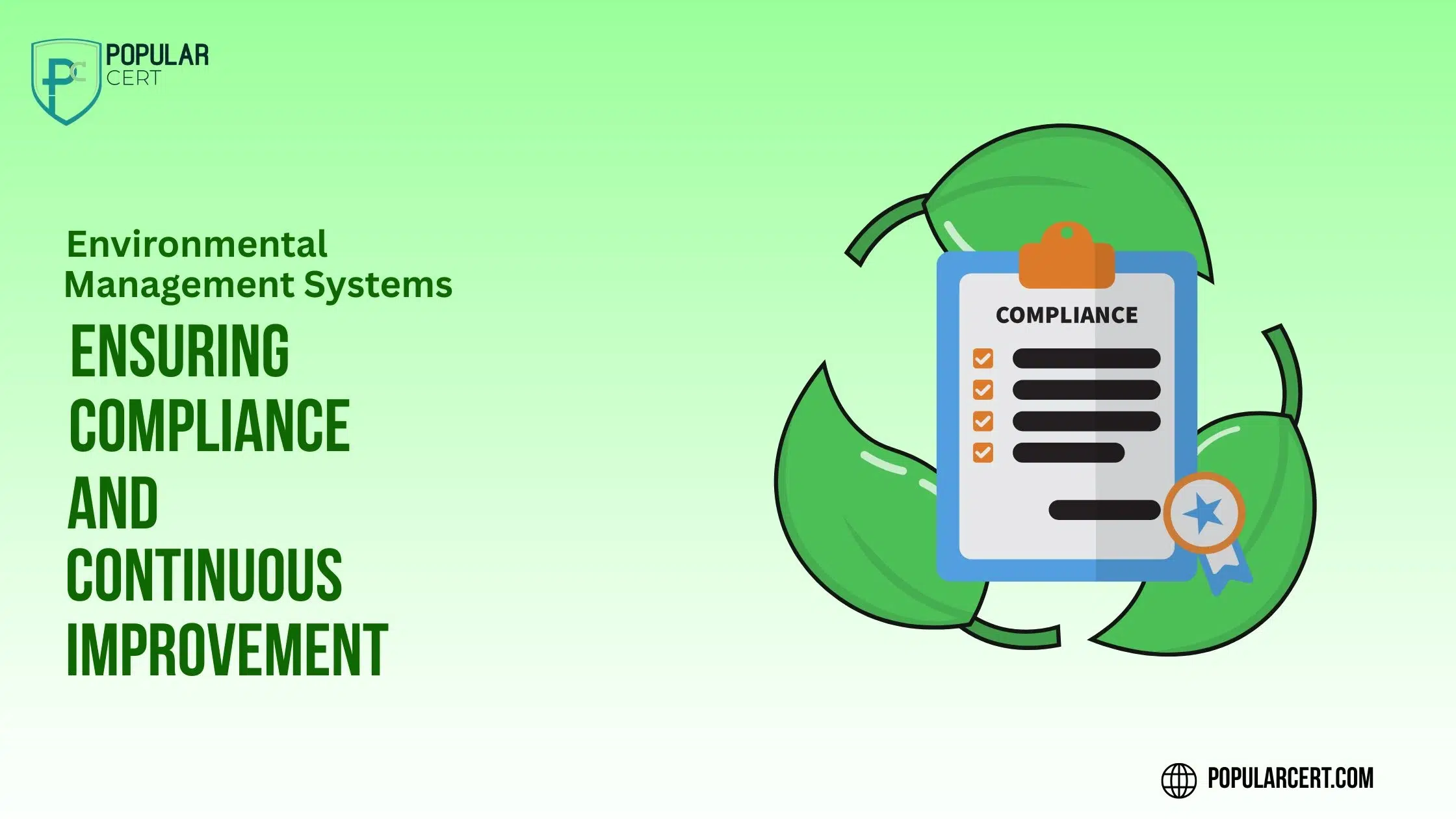Ensuring Compliance and Continuous Improvement in Environmental Management

For organizations committed to environmental sustainability, compliance evaluation and internal audits are critical to maintaining an effective Environmental Management System (EMS). Clause 9.1.2 (Evaluation of Compliance) ensures organizations assess their adherence to environmental regulations, reducing the risk of violations. Clause 9.2 (Internal Audit) emphasizes systematic audits to verify EMS performance and identify areas for improvement. Together, these processes help organizations meet legal requirements, enhance operational efficiency and strengthen their environmental impact management.
9.1.2 Evaluation of compliance
An organization should establish a process to evaluate the extent to which its compliance obligations are fulfilled, by monitoring, measuring, analyzing and reviewing its performance against its compliance obligations. This process can help the organization demonstrate its commitment to fulfil compliance obligations, understand its compliance status, reduce the potential for regulatory violations and avoid adverse action from its interested parties.
Performance against all compliance obligations should be evaluated periodically, although the frequency and the timing of each can differ depending on:
- The organization’s legal requirements.
- Relevance of other requirements adopted as compliance obligations.
- Changes to the compliance obligations.
- The organization’s past performance relating to a compliance obligation, including the potential adverse effects associated with non-compliance.
- Expected variations in performance of a process or activity, e.g. the performance of a waste water treatment plant can vary depending on the volume of waste water received.
Evaluation of compliance should be an iterative process which uses the output from other areas of the environmental management system to determine whether the organization is fulfilling its compliance obligations. Methods used for evaluation of compliance can include gathering information and data, for example through:
- Facility tours or inspections.
- Direct observations or interviews.
- Project or work reviews.
- Review of sample analysis or test results, and comparison to regulatory limits.
- Verification sampling or testing.
- Review of legally required documented information (e.g. hazardous waste manifests, regulatory submittals).
Internal audits can be used to determine the effectiveness of the process(es) established and implemented to evaluate fulfillment of compliance obligations, but they cannot be used to demonstrate that the organization’s compliance obligations have been fulfilled. However, auditing techniques can be applied by the organization to evaluate the fulfilment of its compliance obligations.
Compliance obligations can be taken into account in a variety of environmental management system processes, such as:
- Determination of significant environmental aspects and risks and opportunities that need to be addressed.
- Planning of actions.
- Establishing environmental objectives.
- Development of processes for awareness, external communication, operational planning and control, and monitoring and measurement.
The effectiveness of these processes and the results achieved can also provide evidence of fulfilment of compliance obligations.
The organization can choose to review reports and communication provided by interested parties (eg. regulatory site inspection reports or customer audits), or communicate with interested parties specifically in relation to its compliance obligations.
Where a failure or potential failure to fulfil a compliance obligation is identified, the organization should take action. The organization’s non-conformity and corrective action process could be used to deal with needed corrections. Where appropriate and as required, the organization should communicate or report on failure to fulfil a compliance obligation to the relevant interested party / parties.
A non-compliance is not necessarily elevated to a management system non-conformity if, for example, it is identified and corrected by the environmental management system processes.
By evaluating compliance, the organization gains knowledge and understanding of its compliance status. The frequency of compliance evaluations should be appropriate to keep this knowledge and understanding up to date. Evaluations should be conducted in a manner that provides timely input to the management review so that top management can review the organization’s fulfillment of its compliance obligations and maintain awareness of the organization’s compliance status.
The organization should retain documented information as evidence of its evaluation of compliance. This could include:
- Reports of the results of compliance evaluations.
- Internal and external audit reports.
- Internal and external communications and reports.
Clause 9.2: Internal audit
Internal audits of an organization’s environmental management system should be conducted at planned intervals to determine and provide information to management on whether the system implemented and results can be used to identify opportunities for improving the organization’s environmental management system.
9.2.1 General
The organization shall conduct internal audits at planned intervals to provide information on whether the environmental management system:
1. Conforms to
- The organization’s own requirements for its environmental management system.
- The requirements of this International Standard
2. Is effectively implemented and maintained.
Types Of Certification
- ISO Certification
- ISO 9001 Certification
- ISO 14001 Certification
- ISO 45001 Certification
- ISO 22000 Certification
- ISO 27001 Certification
- ISO 17025 Certification
- ISO 13485 Certification
- ISO 20000-1 Certification
- ISO 22301 Certification
- ISO 50001 Certification
- ISO 37001 Certification
- IATF 16949 Certification
- ISO 29001 Certification
- ISO 31000 Certification
- ISO 20121 Certification
- ISO 10002 Certification
- ISO 41001 Certification
Get Free Consultation
Our Clients


















9.2.2 Internal audit programme
The organization shall establish, implement and maintain an internal audit programme(s), including the frequency, methods, responsibilities, planning requirements and reporting of the internal audits.
When establishing the internal audit programme, the organization shall take into consideration the environmental importance of the processes concerned, changes affecting the organization and the results of previous audits.
The organization shall:
- Define the audit criteria and scope for each audit.
- Select auditors and conduct audits to ensure objectivity and the impartiality of the audit process.
- Ensure that the results of the audits are reported to relevant management.
The organization shall retain documented information as evidence of the implementation of the audit programme and the audit results.
The organization should establish an internal audit programme to direct the planning and conduct of internal audits and to identify the audits needed to achieve the audit programme objectives. The audit programme, and the frequency of internal audits, should be based on the nature of the organization’s operations, in terms of its environmental aspects and potential environmental impacts, risks and opportunities that need to be addressed, the results of previous internal and external audits, and other relevant factors (eg. changes affecting the organization, monitoring and measurement results and previous emergency situations). Outsourced processes that have audit provisions, as controls should be considered in the planning of the audit programme.
The organization should determine the frequency of the internal audits. The audit programme can, for example, cover one year or multiple years, and can consist of one or more audits.
Each internal audit need not cover the entire system, so long as the audit programme ensures that all organizational units and functions, system elements and the full scope of the environmental management system are audited periodically.
The internal audits should be planned and conducted by an objective and impartial auditor or audit team, aided by technical expert(s), where appropriate, selected from within the organization or from external sources. Their collective competence should be sufficient to achieve the audit objective and to meet the scope of the particular audit and provide confidence as to the degree of reliability that can be placed on the results.
The results of an internal audit can be provided in the form of a report as the basis for verification and used to correct or prevent specific nonconformities, or to achieve one or more audit programme objectives, and to provide input to the management review.
The organization should retain documented information as evidence of implementation of the audit programme and the audit results.
Conclusion
Regular compliance evaluation and internal audits are essential for organizations aiming to maintain environmental integrity and regulatory adherence. By systematically assessing compliance and continuously improving EMS performance, organizations can reduce environmental risks, enhance operational efficiency and demonstrate their commitment to sustainability.
Get Certified Today
Boost your organization’s credibility with ISO 14001 certification! PopularCert provides expert guidance to help you achieve environmental compliance and business success. Get in touch with us today to get started!
GET A FREE CONSULTATION NOW
FAQ
Why is compliance evaluation important in environmental management?
Compliance evaluation helps organizations stay aligned with environmental laws, prevent regulatory violations and improve sustainability practices through continuous monitoring.
How often should an organization conduct internal audits?
The frequency depends on the regulatory requirements, environmental risks and previous audit findings — but at least annually is recommended.
What are the benefits of internal audits for EMS?
Internal audits identify system weaknesses, improve compliance, enhance efficiency and ensure continual improvement in environmental performance
